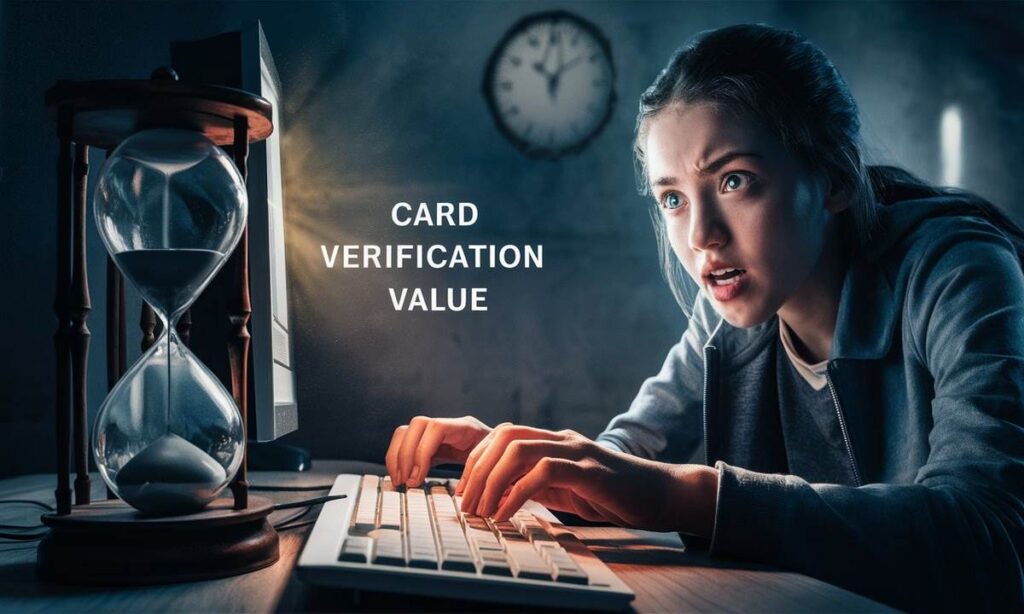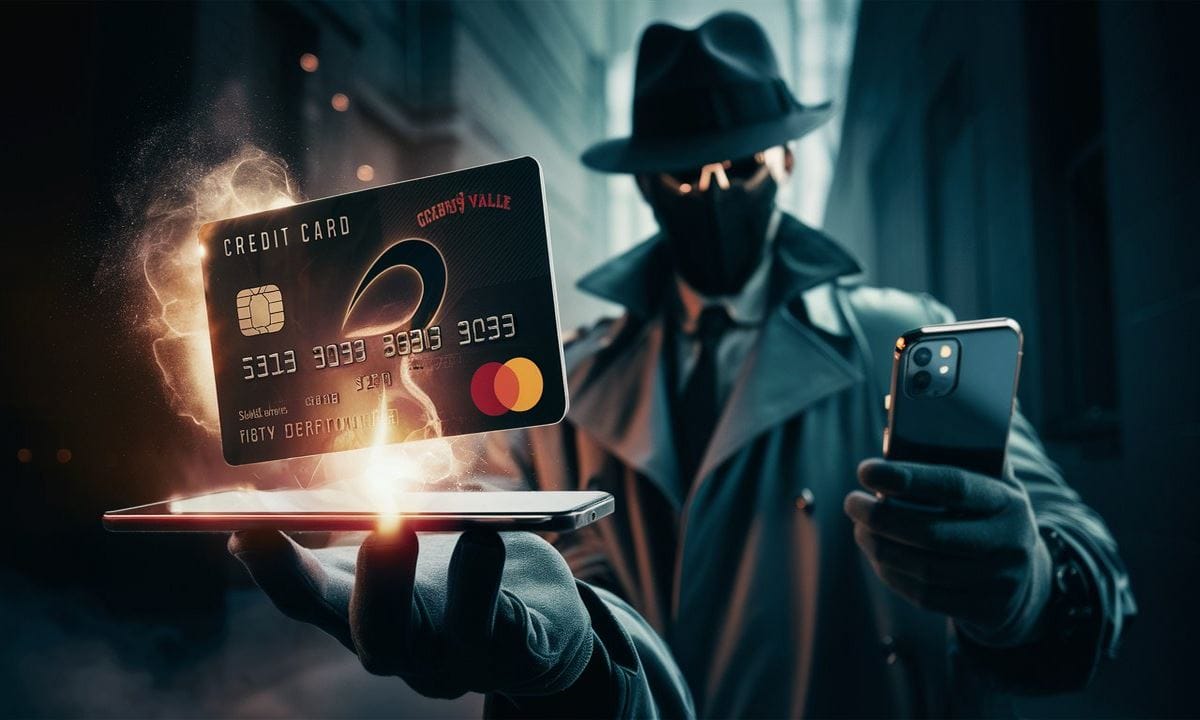Introduction
The Secret Code on Your Card: What is a Card Verification Value?
Ever wondered about the enigmatic trio of digits on the back of your credit or debit card? That’s the Card Verification Value, or CVV, a cryptic code designed to keep your card safe from the perils of online fraud. In the labyrinthine world of digital transactions, this unassuming number is your card’s secret agent, working undercover to prevent unauthorized use and ensure your financial safety.

Why You Should Care About Your CVV: Security in the Digital Age
In today’s hyper-connected world, where your morning coffee purchase can be completed with a swipe and a click, the CVV stands as a crucial bulwark against the tide of cybercrime. It’s the digital equivalent of a bouncer at the club, ensuring only those with proper credentials can gain access to your financial information. Understanding and safeguarding this code is not just prudent—it’s essential in our increasingly digital age.
What This Guide Will Teach You About CVV and Its Importance
This guide is your comprehensive roadmap through the mysterious world of CVV. From its origins and functionality to its role in keeping your financial data secure, we’ll dissect every facet of this vital security feature. By the end, you’ll be equipped with the knowledge to not only understand but also protect this pivotal piece of your financial puzzle.

The Basics of Card Verification Value (CVV)
Defining CVV: What Do Those Three Little Numbers Mean?
The CVV, or Card Verification Value, is a three-digit code located on the back of your card, or four digits on the front for American Express cards. It’s a safeguard that verifies you’re in possession of the actual card during transactions. Think of it as a digital fingerprint that provides an additional layer of security beyond the card number itself.
The History of CVV: How This Security Feature Came to Be
The CVV was introduced in the 1990s as part of an effort to bolster online transaction security. Before its inception, card transactions were vulnerable to various forms of fraud due to the ease with which card numbers could be stolen and misused. The CVV was conceived as a solution to this problem, adding an extra hurdle for would-be thieves and fortifying the defenses of cardholders’ financial information.
Where to Find Your CVV: A Quick Guide to Locating It
Locating your CVV is straightforward. On Visa, MasterCard, and Discover cards, it’s the three-digit number printed on the signature strip on the back. For American Express cards, it’s a four-digit number found on the front of the card, above the embossed card number. This small but mighty code plays a big role in securing your card transactions.

The Role of CVV in Online Transactions
Why Your CVV is Essential for Online Shopping
When you shop online, the CVV is your card’s way of saying, “Yes, I’m real, and I’m right here with you.” It ensures that the person making the purchase has physical possession of the card, thus adding a layer of authentication to online transactions where the card is not physically present. This helps to mitigate the risks associated with card-not-present transactions.
How CVV Protects Against Fraud: The First Line of Defense
The CVV serves as an initial line of defense against fraudulent transactions. By requiring this code, merchants add an extra step that thieves must overcome. Even if someone obtains your card number through illicit means, they still need the CVV to complete an online purchase. This additional requirement helps to thwart many attempts at fraud and protects your financial assets.
The Difference Between CVV and Other Security Codes: PINs, CVC, and More
While CVV, CVC (Card Verification Code), and PIN (Personal Identification Number) all serve to protect your financial information, they operate differently. The CVV is used primarily for online and card-not-present transactions, while a PIN is used for in-person transactions at ATMs or point-of-sale terminals. Each code has its specific function, but all contribute to a comprehensive security strategy.

How CVV Works Behind the Scenes
The Technology Behind CVV: How It Keeps Your Data Safe
The CVV is more than just a random set of numbers; it’s a result of sophisticated technology designed to keep your data secure. It is generated using cryptographic algorithms that ensure the code cannot be easily guessed or reproduced. When you enter your CVV during a transaction, the merchant’s system verifies it against the card issuer’s records to confirm its validity.
The CVV Check Process: What Happens When You Enter Those Digits
When you enter your CVV at checkout, it gets encrypted and sent to the card issuer for verification. The issuer’s system cross-references the code with the one on file. If it matches, the transaction proceeds; if not, it’s flagged and rejected. This real-time validation process helps prevent unauthorized transactions and ensures that only legitimate purchases are completed.
What Makes CVV Unique? Understanding the Generation and Validation
CVV codes are uniquely generated for each card and are designed to be transient and non-reproducible. They are not stored with the card’s magnetic stripe data, adding an extra layer of security. This uniqueness ensures that even if a fraudster obtains your card number, they cannot use it without also having the correct CVV.
The Evolution of Card Security
From Magnetic Stripes to EMV Chips: The Journey to CVV
The journey from magnetic stripes to EMV chips represents a significant leap in card security. While magnetic stripes were once the standard, they were vulnerable to skimming and fraud. The introduction of EMV chips and CVV codes marked a shift towards more secure transaction methods, with chips offering enhanced encryption and CVV codes providing an additional layer of authentication.
How CVV Compares to Other Security Measures in Card Technology
While CVV codes are a crucial security measure, they are part of a broader ecosystem that includes EMV chips, tokenization, and biometric authentication. Each of these technologies plays a role in enhancing card security, with CVV serving as an essential component in the online and card-not-present transaction realms. Comparing CVV to these other measures highlights its unique role and importance in the security landscape.
The Future of Card Security: What Comes After CVV?
As technology evolves, so too will card security measures. While CVV codes have served us well, future advancements may include more sophisticated authentication methods such as biometric identifiers or advanced cryptographic techniques. The ongoing challenge will be to stay ahead of evolving threats and continually enhance the security of financial transactions.
Common Myths About CVV
Myth-Busting: Is CVV Really Necessary for Every Transaction?
Despite its importance, there is a misconception that CVV codes are not necessary for every transaction. In reality, the CVV plays a critical role in online and card-not-present transactions, where physical card verification is not possible. It is a key component of fraud prevention and is essential for maintaining the security of card transactions.
Debunking the Myth: Can Your CVV Be Easily Hacked?
A common myth is that CVV codes can be easily hacked or guessed. In truth, CVV codes are designed to be secure and are not stored with the card number or magnetic stripe data. While no security measure is foolproof, the CVV code’s generation and validation processes make it a robust defense against casual attempts at hacking.
Clearing Up Confusion: CVV on Virtual Cards vs. Physical Cards
There is often confusion about whether CVV codes on virtual cards differ from those on physical cards. While the format and function of CVV codes remain the same, virtual cards often have dynamically changing CVV codes for added security. This means that even if a virtual card’s CVV is compromised, it changes periodically, reducing the risk of fraud.

CVV and Fraud Prevention
How CVV Helps in the Fight Against Credit Card Fraud
CVV codes are a pivotal element in the battle against credit card fraud. By requiring a code that is not stored on the card’s magnetic stripe, CVV codes provide an additional verification step that helps prevent unauthorized use. This extra layer of security is particularly important for online transactions, where physical card verification is not possible.
Real-Life Examples: When CVV Saved the Day
There are numerous instances where CVV codes have thwarted fraud attempts. For example, if a fraudster obtains a stolen card number but does not have the CVV, their attempt to make an online purchase will be unsuccessful. These real-life scenarios underscore the importance of the CVV in protecting cardholders from financial loss.
What Happens if Your CVV Is Stolen? Steps to Take Immediately
If your CVV is stolen, it’s crucial to act swiftly. Contact your card issuer immediately to report the theft and request a new card. Monitor your account for any unauthorized transactions and take steps to secure your personal information. Prompt action can help mitigate the damage and prevent further misuse of your financial data.
Understanding the Different Types of CVV
CVV1 vs. CVV2: What’s the Difference?
CVV1 and CVV2 are two different types of security codes associated with card transactions. CVV1 is encoded on the magnetic stripe and used primarily for in-person transactions, while CVV2 is printed on the card and used for online and card-not-present transactions. The key difference lies in their usage and storage, with CVV2 offering an added layer of security for online transactions.
What Is a Dynamic CVV? The New Wave of Security
Dynamic CVV is an innovative security feature that generates a new CVV code at regular intervals. This code changes periodically, making it significantly harder for fraudsters to use stolen card information. Dynamic CVVs are a cutting-edge development in card security, providing enhanced protection against card-not-present fraud.
How Banks and Issuers Implement Different CVV Types
Banks and issuers implement CVV codes in various ways to enhance security. While CV
V1 is used for transactions involving magnetic stripes, CVV2 is employed for online transactions. The introduction of dynamic CVVs represents a further advancement, with issuers incorporating these codes into their systems to provide even greater protection for cardholders.

The Global Perspective on CVV
How CVV Usage Differs Across Countries
The usage of CVV codes can vary by country, influenced by regional payment practices and security requirements. In some countries, CVV codes are more rigorously enforced, while in others, alternative security measures may be used. Understanding these differences can provide insights into how global payment systems operate and how CVV codes fit into the broader security landscape.
International Transactions: How Your CVV Protects You Abroad
When traveling abroad, your CVV continues to play a crucial role in protecting your card transactions. It ensures that even if your card details are compromised, the additional verification step provided by the CVV helps to prevent unauthorized use. This added layer of security is particularly important for international transactions, where card fraud can be more prevalent.
The Role of CVV in Contactless Payments and Mobile Wallets
In the realm of contactless payments and mobile wallets, CVV codes are integrated into the security protocols to ensure safe transactions. While the use of CVV codes may differ slightly in these contexts, their role in verifying cardholder identity and preventing fraud remains essential. As payment technologies evolve, the CVV continues to be a fundamental component of secure financial transactions.
Legal and Regulatory Aspects of CVV
How CVV Is Regulated: A Look at Global Standards
CVV codes are subject to various global standards and regulations aimed at protecting cardholder information. Regulatory frameworks such as PCI DSS (Payment Card Industry Data Security Standard) set forth guidelines for the secure handling of CVV codes, ensuring that card issuers and merchants implement proper security measures to safeguard financial data.
The Legal Requirements for Merchants to Use CVV
Merchants are legally required to follow specific guidelines regarding the handling and storage of CVV codes. These requirements are designed to protect cardholder information and prevent misuse. Merchants must ensure that CVV codes are not stored after authorization, adhering to best practices for data security and compliance.
The Impact of GDPR and Data Privacy Laws on CVV Use
Data privacy laws such as the General Data Protection Regulation (GDPR) have a significant impact on how CVV codes are managed. These regulations mandate strict guidelines for data protection and privacy, affecting how CVV codes are collected, processed, and stored. Compliance with GDPR helps ensure that cardholder information is handled responsibly and securely.
How to Keep Your CVV Safe
Best Practices for Protecting Your CVV from Theft
Protecting your CVV involves several best practices. Keep your card in a secure place, avoid sharing your CVV over unsecured channels, and monitor your account regularly for suspicious activity. Additionally, be cautious when entering your CVV online, ensuring that you are on a secure and legitimate website.
Common Scams Targeting CVV: How to Spot and Avoid Them
Scammers employ various tactics to obtain CVV codes, including phishing emails and fraudulent websites. To protect yourself, be wary of unsolicited requests for your CVV, verify the legitimacy of websites before entering your information, and avoid clicking on suspicious links. Awareness and vigilance are key to avoiding common scams targeting CVV codes.
The Importance of Secure Websites When Entering Your CVV
When entering your CVV online, ensure that the website is secure and trustworthy. Look for indicators such as HTTPS in the URL and a padlock icon in the address bar. A secure website helps protect your CVV from being intercepted by malicious actors and ensures that your financial information is handled safely.

CVV in the Age of Digital Payments
How CVV Works with Mobile Payments and Digital Wallets
In the world of mobile payments and digital wallets, CVV codes are integrated into the security protocols to safeguard transactions. While the specifics may vary, CVV codes continue to play a role in verifying cardholder identity and preventing unauthorized transactions, even in the digital realm.
The Role of CVV in Peer-to-Peer Payment Platforms
Peer-to-peer payment platforms also utilize CVV codes to enhance security. These platforms often require CVV codes to verify transactions and ensure that users are in possession of the actual card. This added layer of security helps protect against fraud and unauthorized transfers within these digital ecosystems.
Future Trends: Will CVV Still Matter in a Cashless Society?
As we move towards a cashless society, the role of CVV codes may evolve. Emerging technologies such as biometric authentication and tokenization are reshaping the landscape of payment security. While CVV codes will likely remain a component of card security for the foreseeable future, their prominence may shift as new methods of authentication and protection emerge.
Consumer Rights and CVV
What Are Your Rights if Your CVV Is Compromised?
If your CVV is compromised, you have certain rights as a consumer. You are entitled to report the issue to your card issuer, who is responsible for investigating and resolving unauthorized transactions. Additionally, you may be entitled to a refund or reimbursement for any fraudulent charges, depending on your card issuer’s policies.
How to Dispute Unauthorized Transactions Involving Your CVV
To dispute unauthorized transactions involving your CVV, contact your card issuer immediately. Provide details of the transaction and any supporting evidence to assist with the investigation. Your issuer will review the claim and take appropriate action to resolve the issue and prevent further unauthorized use.
The Role of Banks in Protecting Your CVV and Financial Data
Banks play a crucial role in protecting your CVV and financial data. They implement security measures such as encryption and fraud detection systems to safeguard your information. Additionally, banks are responsible for responding to security breaches and assisting customers in resolving issues related to compromised CVV codes.
Comparing CVV Across Different Card Networks
Visa vs. Mastercard vs. Amex: Do Their CVVs Differ?
While Visa, Mastercard, and American Express all use CVV codes, there are some differences in their implementation. Visa and Mastercard typically use a three-digit CVV code on the back of the card, while American Express uses a four-digit code on the front. Despite these differences, the fundamental purpose of the CVV remains the same: to provide an additional layer of security for card transactions.
How Different Payment Processors Handle CVV Data
Different payment processors have varying methods for handling CVV data. While the core functionality of the CVV is consistent, processors may employ different security measures and technologies to protect this information. Understanding how your payment processor manages CVV data can provide insights into the security practices in place for your transactions.
The Role of CVV in Contactless Payments Across Networks
In contactless payments, the role of CVV codes varies depending on the network and technology used. While some networks incorporate CVV codes into their contactless payment systems, others rely on alternative security measures. The key is that all systems aim to provide secure and reliable transactions, with CVV codes being one of many tools used to prevent fraud.
Frequently Asked Questions (FAQs)
What is PIN verification value?
PIN verification value, or PVV, is a security code used in conjunction with a PIN (Personal Identification Number) to authenticate card transactions. It is typically used in systems like EMV (Europay, MasterCard, and Visa) to enhance security by ensuring that the PIN entered during a transaction matches the encrypted PIN stored on the card. This helps prevent fraud and unauthorized access to your account.
Where is Card Verification Value on debit card?
On a debit card, the Card Verification Value (CVV) is typically located on the back of the card, to the right of the signature strip. It is a three-digit number that provides an extra layer of security for online and card-not-present transactions. For American Express cards, the CVV is a four-digit number found on the front of the card, above the embossed card number.
What is the authentication verification value?
The authentication verification value (AVV) is a security feature used in payment card systems to verify the authenticity of a transaction. It is a code generated during the transaction process that helps confirm that the transaction data has not been altered or tampered with. The AVV is used in conjunction with other security measures, such as CVV, to ensure the integrity and security of card transactions.
What is the meaning of 2 step verification?
Two-step verification, also known as two-factor authentication (2FA), is a security process that requires two forms of identification before granting access to an account or completing a transaction. Typically, this involves something you know (such as a password) and something you have (like a code sent to your phone). This additional layer of security helps protect against unauthorized access and enhances the overall security of your accounts.
What is the meaning of PVV?
PVV, or PIN Verification Value, is a security feature used in the payment card industry to validate the PIN entered during a transaction. It is a value encrypted on the card’s magnetic stripe or chip that is used to compare with the PIN entered by the cardholder. This verification process helps ensure that the PIN is correct and prevents fraudulent transactions.
Why does my card have 2 CVV?
Some cards have two CVV numbers to provide added security and flexibility. For instance, one CVV might be used for online transactions, while the other is used for in-person transactions. This separation helps enhance security by using different codes for different types of transactions, reducing the risk of fraud and unauthorized use.
What is two step verification for credit card?
Two-step verification for credit cards involves an additional layer of security to protect against unauthorized transactions. It typically includes something you know (like your credit card number and CVV) and something you have (such as a code sent to your mobile device). This process helps verify that you are the legitimate cardholder and prevents fraudulent activity.
What is verification value?
Verification value is a general term that refers to any code or piece of data used to confirm the authenticity of a transaction or cardholder. This can include CVV codes, PINs, and other security codes that help validate the legitimacy of a card transaction or access request.
What is the 4 digit verification value?
The four-digit verification value is often referred to as the Card Verification Code (CVC) used for American Express cards. This code is printed on the front of the card, above the embossed card number, and is used to provide an extra layer of security for online and card-not-present transactions.
What is Card Verification Value 2?
Card Verification Value 2 (CVV2) is the security code used on credit and debit cards to enhance transaction security. It is a three-digit code located on the back of most cards (four digits on American Express cards), used to verify that the cardholder has the physical card in hand during online or card-not-present transactions.
What are the 2 main verification methods?
The two main verification methods for card transactions are:
- Card Verification Code (CVC/CVV): A security code printed on the card that helps verify that the cardholder has the physical card during transactions.
- PIN (Personal Identification Number): A numeric code entered by the cardholder at the point of sale or ATM to authenticate transactions.
What is card verification?
Card verification is the process of confirming the authenticity of a credit or debit card during a transaction. This typically involves checking the card number, CVV code, and other security features to ensure that the card is valid and that the transaction is authorized.
What is cardholder verification in EMV?
Cardholder verification in EMV (Europay, MasterCard, and Visa) refers to the process of validating the identity of the cardholder during a transaction. This can include PIN entry, signature verification, or biometric methods, depending on the card and transaction type. EMV technology enhances security by requiring cardholder verification before completing a transaction.
What are the 4 methods of verification?
The four methods of verification for card transactions are:
- PIN (Personal Identification Number): Entered by the cardholder to verify their identity.
- Signature: Verified by comparing it to the signature on the card.
- Card Verification Code (CVC/CVV): A code printed on the card used for online transactions.
- Biometric Verification: Includes fingerprint or facial recognition technology used for advanced authentication.
What is the CVM limit?
The Cardholder Verification Method (CVM) limit is the maximum amount for which a transaction can be authorized without requiring full cardholder verification, such as entering a PIN. Transactions below this limit may not require PIN entry, depending on the card issuer’s policies and the payment system’s regulations.
Which cards have VBV?
Verified by Visa (VBV) is a security feature used by Visa cards to provide additional authentication for online transactions. Other card networks have similar features, such as Mastercard SecureCode and American Express SafeKey. VBV helps prevent fraud by requiring an additional password or code during online purchases.
How to calculate CVV?
CVV codes are not calculated by users; they are generated by the card issuer and encoded on the card’s magnetic stripe or chip. The CVV is a result of cryptographic algorithms used to secure the card’s data. To obtain or change your CVV, contact your card issuer.
How to verify credit cards?
Credit cards are verified through a combination of methods including checking the card number, expiration date, CVV code, and sometimes requiring additional authentication such as a PIN or password. This process ensures that the card is valid and that the transaction is authorized.
How does EMV work?
EMV (Europay, MasterCard, and Visa) technology uses smart chips embedded in cards to enhance security during transactions. When a card is used, the chip generates a unique transaction code that is difficult to duplicate. This process includes encryption and authentication steps to protect against fraud and ensure the cardholder’s information is secure.
Can You Make a Purchase Without a CVV? The Real Answer
In most cases, you cannot complete an online or card-not-present transaction without a CVV. Merchants require this code as part of the authorization process to verify that you have the physical card in hand. However, in some instances, merchants may allow purchases without a CVV for specific types of transactions or under certain conditions.
What to Do If You Forget or Lose Your CVV
If you forget or lose your CVV, contact your card issuer immediately to request a replacement card. They will issue a new card with a new CVV and cancel the old one to prevent any potential misuse. Keeping a record of your CVV in a secure location can help prevent future issues.
How Often Should You Update or Change Your CVV?
Typically, you do not need to update or change your CVV frequently, as it remains the same until you request a new card. However, if you suspect that your CVV has been compromised or if you experience any security concerns, it is advisable to request a new card with a different CVV to ensure your information remains protected.
BOTTOM LINE
Recap: The Importance of Understanding What is a Card Verification Value
Understanding the Card Verification Value is crucial for maintaining your financial security. This small but significant code provides an additional layer of protection against fraud, particularly in online and card-not-present transactions. By knowing how CVV works and how to safeguard it, you can better protect your financial information.
Final Thoughts: How CVV Fits into Your Overall Financial Security
CVV codes are an integral part of the broader security framework designed to protect your financial data. While they are just one element of a multi-faceted approach to security, their role in verifying cardholder identity and preventing unauthorized transactions cannot be overstated. Integrating CVV protection with other security measures ensures a robust defense against fraud.
Next Steps: Keeping Your CVV and Financial Information Secure
To keep your CVV and financial information secure, practice good security habits such as monitoring your account regularly, using secure websites, and being cautious of phishing attempts. By staying vigilant and informed, you can help safeguard your financial data and enjoy greater peace of mind in the digital age.









